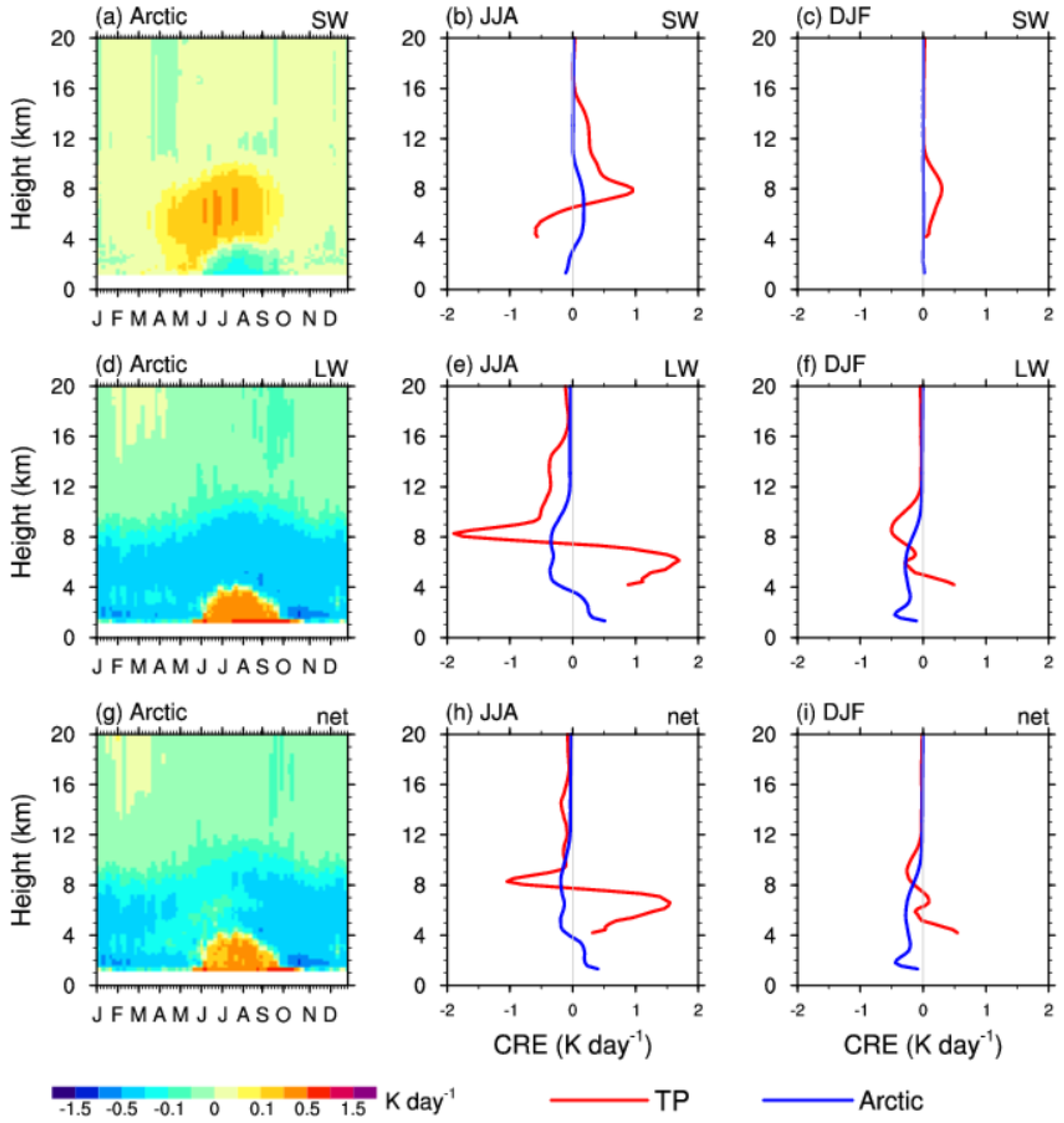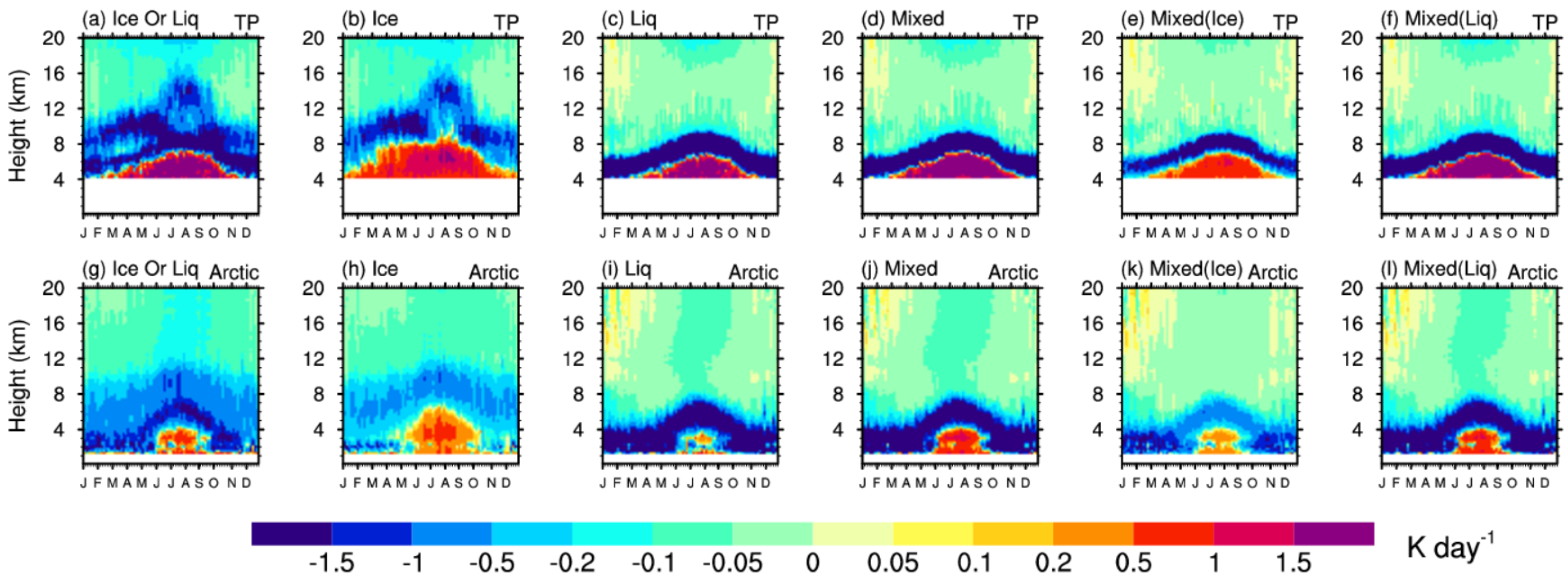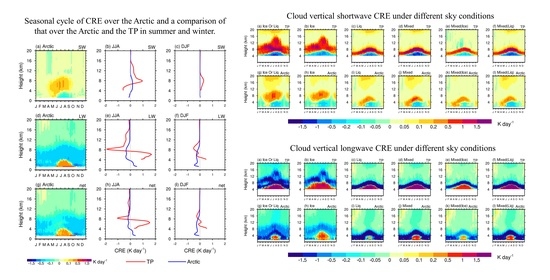Effects of Cloud Microphysics on the Vertical Structures of Cloud Radiative Effects over the Tibetan Plateau and the Arctic
Abstract
1. Introduction
2. Data and Methodology
2.1. Data
2.2. The Rapid Radiative Transfer Model (RRTM)
3. Results
3.1. Vertical Structures of the Cloud Microphysics
3.2. Vertical Structures of the Cloud Radiative Effects (CRE)
3.3. Calculations of Vertical CRE under Different Cloud Microphysical Conditions
4. Conclusions and Discussion
- (1)
- More plentiful cloud water particles with larger sizes and more supercooled water in the liquid phase were found over the TP than over the Arctic. Even though cloud particles in both phases are located at high altitudes in boreal summer and at low altitudes in boreal winter, cloud water particles are more abundant and much larger and the layer with the large particles is thicker over the TP than over the Arctic. Compared with the Arctic, the vast majority of liquid water clouds over the TP are supercooled and are distributed at high altitudes in boreal summer, which is more conducive to the formation of mixed-phase clouds.
- (2)
- The greater quantities and larger sizes of liquid and solid cloud particles over the TP result in a much stronger SW cooling CRE and stronger LW heating CRE and net CRE at low altitudes and a much stronger SW heating CRE and stronger LW cooling CRE and net CRE at high altitudes there than over the Arctic. During boreal winter, the appearance of cooling LW and the net CRE at low altitudes over the Arctic is opposite to that over the TP, which may be associated with the distinct local atmospheric circulations over the two regions and the mechanism between them needs further research.
- (3)
- Further model calculations demonstrated the influence of the cloud microphysical distributions on the vertical structures of CREs. Ice cloud water primarily dominates the CRE vertical structures at high altitudes above 8 km, while cloud liquid water and mixed-phase cloud water (especially the liquid water in the mixed-phase clouds) primarily dominate the CRE vertical structures at low altitudes. The strong shallow heating layer above the cooling layer in the SW CRE and the strong shallow cooling layer above the heating layer in the LW CRE are primarily caused by cloud liquid water and mixed-phase water (especially the liquid water in the mixed-phase clouds). Compared with the Arctic, the cloud microphysics over the TP lead to very uneven vertical distributions of net CREs with a much stronger heating layer above the ground surface and almost comparable cooling layer above the heating layer caused by cloud water in the same phase.
Author Contributions
Funding
Institutional Review Board Statement
Informed Consent Statement
Data Availability Statement
Acknowledgments
Conflicts of Interest
References
- Harrison, E.F.; Minnis, P.; Barkstrom, B.R.; Ramanathan, V.; Cess, R.D.; Gibson, G.G. Seasonal variation of cloud radiative forcingderived from the Earth Radiation Budget Experiment. J. Geophys. Res. 1990, 95, 18687–18703. [Google Scholar] [CrossRef]
- Stephens, G.L. Cloud feedbacks in the climate system: A critical review. J. Climate 2005, 18, 237–273. [Google Scholar] [CrossRef]
- Koren, I.; Martins, J.V.; Remer, L.A.; Afargan, H. Smoke invigoration versus inhibition of clouds over the Amazon. Science 2008, 321, 946–949. [Google Scholar] [CrossRef]
- Rosenfeld, D.; Lohmann, U.; Raga, G.B.; O’Dowd, C.; Kulmala, M.; Fuzzi, S.; Reissell, A.; Andreae, M.O. Flood or drought: How do aerosols affect precipitation? Science 2008, 321, 1309–1313. [Google Scholar] [CrossRef]
- Andrews, T.; Forster, P.M.; Boucher, O.; Bellouin, N.; Jones, A. Forcing, feedbacks and climate sensitivity in CMIP5 coupled atmosphere–ocean climate models. Geophys. Res. Lett. 2012, 39, L09712. [Google Scholar] [CrossRef]
- Jiang, J.H.; Su, H.; Zhai, C.; Perun, V.S.; Del Genio, A.; Nazarenko, L.S.; Donner, L.J.; Horowitz, L.; Seman, C.; Cole, J.; et al. Evaluation of cloud and water vapor simulations in CMIP5 climate models using NASA “A-Train” satellite observations. J. Geophys. Res. 2012, 117, D14105. [Google Scholar] [CrossRef]
- Su, H.; Jiang, J.H.; Zhai, C.; Shen, T.J.; Neelin, J.D.; Stephens, G.L.; Yung, Y.L. Weakening and strengthening structures in the Hadley Circulation change under global warming and implications for cloud response and climate sensitivity. J. Geophys. Res. Atmos. 2014, 119, 5787–5805. [Google Scholar] [CrossRef]
- Collins, M.; Knutti, R.; Arblaster, J.; Dufresne, J.-L.; Fichefet, T.; Friedlingstein, P.; Gao, X.; Gutowski, W.J.; Johns, T.; Krinner, G.; et al. Long-term climate change: Projections, commitments and irreversibility. In Climate Change 2013: The Physical Science Basis. Contribution of Working Group I to the Fifth Assessment Report of the Intergovernmental Panel on Climate Change; Cambridge University Press: Cambridge, UK; New York, NY, USA, 2013; pp. 1029–1136. [Google Scholar] [CrossRef]
- Rangwala, I.; Sinsky, E.; Miller, J.R. Amplified warming projections for high altitude regions of the Northern Hemisphere mid-latitudes from CMIP5 models. Environ. Res. Lett. 2013, 8, 024040. [Google Scholar] [CrossRef]
- Wu, G.; Zhang, Y. Tibetan Plateau forcing and the timing of the monsoon onset over South Asia and the South China Sea. Mon. Weather Rev. 1998, 126, 913–927. [Google Scholar] [CrossRef]
- Duan, A.M.; Wu, G.X. Role of the Tibetan Plateau thermal forcing in the summer climate patterns over subtropical Asia. Clim. Dyn. 2005, 24, 793–807. [Google Scholar] [CrossRef]
- Liu, Y.; Bao, Q.; Duan, A.; Qian, Z.; Wu, G. Recent progress in the impact of the Tibetan Plateau on climate in China. Adv. Atmos. Sci. 2007, 24, 1060–1076. [Google Scholar] [CrossRef]
- Liu, Y.; Lu, M.; Yang, H.; Duan, A.; He, B.; Yang, S.; Wu, G. Land–atmosphere–ocean coupling associated with the Tibetan Plateau and its climate impacts. Natl. Sci. Rev. 2020, 7, 534–552. [Google Scholar] [CrossRef]
- Fujinami, H.; Yasunari, T. The seasonal and intraseasonal variability of diurnal cloud activity over the Tibetan Plateau. J. Meteor. Soc. Jpn. 2001, 79, 1207–1227. [Google Scholar] [CrossRef]
- Li, Y.; Liu, X.; Chen, B. Cloud type climatology over the Tibetan Plateau: A comparison of ISCCP and MODIS/TERRA measurements with surface observations. Geophys. Res. Lett. 2006, 33, L17716. [Google Scholar] [CrossRef]
- Luo, Y.; Zhang, R.; Qian, W.; Luo, Z.; Hu, X. Inter-comparison of deep convection over the Tibetan Plateau–Asian monsoon region and subtropical north America in boreal summer using CloudSat/CALIPSO data. J. Clim. 2011, 24, 2164–2177. [Google Scholar] [CrossRef]
- Rüthrich, F.; Thies, B.; Reudenbach, C.; Bendix, J. Cloud detection and analysis on the Tibetan Plateau using Meteosat and CloudSat. J. Geophys. Res. Atmos. 2013, 118, 10082–10099. [Google Scholar] [CrossRef]
- Hong, Y.; Liu, G. The characteristics of ice cloud properties derived from CloudSat and CALIPSO measurements. J. Clim. 2015, 28, 3880–3901. [Google Scholar] [CrossRef]
- Yan, Y.; Liu, Y.; Lu, J. Cloud vertical structure, precipitation, and cloud radiative effects over Tibetan Plateau and its neighboring regions. J. Geophys. Res. Atmos. 2016, 121. [Google Scholar] [CrossRef]
- Yan, Y.-F.; Wang, X.-C.; Liu, Y.-M. Cloud vertical structures associated with precipitation magnitudes over the Tibetan Plateau and its neighboring regions. Atmos. Ocean. Sci. Lett. 2018, 11, 44–53. [Google Scholar] [CrossRef]
- Yan, Y.; Liu, Y. Vertical structures of convective and stratiform clouds in boreal summer over the Tibetan Plateau and its neighboring regions. Adv. Atmos. Sci. 2019, 36, 1089–1102. [Google Scholar] [CrossRef]
- Miao, H.; Wang, X.; Liu, Y.; Wu, G. An evaluation of cloud vertical structure in three reanalyses against CloudSat/cloud-aerosol lidar and infrared pathfinder satellite observations. Atmos. Sci. Lett. 2019, 20, e906. [Google Scholar] [CrossRef]
- Lingen, B.; Longhua, L.; Changgui, L.; Yanjie, C.; Zhiqiu, G.; Huizhi, L.; Jiayi, C. The characteristics of radiation balance components of the Tibetan Plateau in the summer of 1998. Chin. J. Atmos. Sci. 2001, 25, 577–588. [Google Scholar]
- CiRen, N.M.; DanZeng, L.B.; Xuan, Y.J.; Chen, T.L. Characteristic of seasonal variation of surface radiation balance at Yangbajin in Qinghai-Xizang plateau. Plateau Meteor. 2013, 32, 1253–1260. [Google Scholar] [CrossRef]
- Su, W.; Mao, J.; Ji, F.; Qin, Y. Outgoing longwave radiation and cloud radiative forcing of the Tibetan plateau. J. Geophys. Res. Atmos. 2000, 105, 14863–14872. [Google Scholar] [CrossRef]
- Naud, C.M.; Rangwala, I.; Xu, M.; Miller, J.R. A satellite view of the radiative impact of clouds on surface downward fluxes in the Tibetan plateau. J. Appl. Meteorol. Clim. 2012, 54, 479–493. [Google Scholar] [CrossRef]
- Lu, J.; Cai, M. Seasonality of polar surface warming amplification in climate simulations. Geophys. Res. Lett. 2009, 36, L16704. [Google Scholar] [CrossRef]
- Intrieri, J.; Fairall, C.; Shupe, M.D.; Persson, P.O.G.; Andreas, E.L.; Guest, P.S.; Moritz, R.E. An annual cycle of Arctic surface cloud forcing at SHEBA. J. Geophys. Res. Ocean. 2002, 107, 8039. [Google Scholar] [CrossRef]
- Tjernström, M.; Sedlar, J.; Shupe, M.D. How well do regional climate models reproduce radiation and clouds in the Arctic? An evaluation of ARCMIP simulations. J. Appl. Meteorol. Clim. 2008, 47, 2405–2422. [Google Scholar] [CrossRef]
- Kay, J.E.; Gettelman, A. Cloud influence on and response to seasonal Arctic Sea ice loss. J. Geophys. Res. Atmos. 2009, 114, D18204. [Google Scholar] [CrossRef]
- Schweiger, A.J.; Lindsay, R.W.; Vavrus, S.; Francis, J.A. Relationships between Arctic Sea ice and clouds during autumn. J. Clim. 2008, 21, 4799–4810. [Google Scholar] [CrossRef]
- Johansson, E.; Devasthale, A.; Tjernström, M.; Ekman, A.M.L.; L’Ecuyer, T. Response of the lower troposphere to moisture intrusions into the Arctic. Geophys. Res. Lett. 2017, 44, 2527–2536. [Google Scholar] [CrossRef]
- Kay, J.E.; L’Ecuyer, T.; Gettelman, A.; Stephens, G.; O’Dell, C. The contribution of cloud and radiation anomalies to the 2007 Arctic Sea ice extent minimum. Geophys. Res. Lett. 2008, 35, L08503. [Google Scholar] [CrossRef]
- Vavrus, S.; Holland, M.M.; Bailey, D.A. Changes in Arctic clouds during intervals of rapid sea ice loss. Clim. Dyn. 2011, 36, 1475–1489. [Google Scholar] [CrossRef]
- Abe, M.; Nozawa, T.; Ogura, T.; Takata, K. Effect of retreating sea ice on Arctic cloud cover in simulated recent global warming. Atmos. Chem. Phys. 2016, 16, 14343–14356. [Google Scholar] [CrossRef]
- Shupe, M.D.; Intrieri, J. Cloud radiative forcing of the Arctic surface: The influence of cloud properties, surface albedo, and solar zenith angle. J. Clim. 2004, 17, 616–628. [Google Scholar] [CrossRef]
- Francis, J.A.; Hunter, E. New insight into the disappearing arctic sea ice. EOS Trans. Am. Geophys. Union 2006, 87, 509–524. [Google Scholar] [CrossRef]
- Wyser, K.; Jones, C.G.; Du, P.; Girard, E.; Willén, U.; Cassano, J.; Christensen, J.H.; Curry, J.A.; Dethloff, K.; Haugen, J.-E.; et al. An evaluation of Arctic cloud and radiation processes during the SHEBA year: Simulation results from eight Arctic regional climate models. Clim. Dyn. 2008, 30, 203–223. [Google Scholar] [CrossRef]
- Klein, S.A.; McCoy, R.B.; Morrison, H.; Ackerman, A.; Avramov, A.; de Boer, G.; Chen, M.; Cole, J.N.S.; Del Genio, A.D.; Falk, M.; et al. Intercomparison of model simulations of mixed-phase clouds observed during the ARM Mixed-Phase Arctic Cloud Experiment. I: Single-layer cloud. Quart. J. Roy. Meteor. Soc. 2009, 135, 979–1002. [Google Scholar] [CrossRef]
- Morrison, H.; McCoy, R.B.; Klein, S.; Xie, S.; Luo, Y.; Avramov, A.; Chen, M.; Cole, J.N.S.; Falk, M.; Foster, M.J.; et al. Intercomparison of model simulations of mixed-phase clouds observed during the ARM Mixed-Phase Arctic Cloud Experiment. II: Multilayer cloud. Quart. J. Roy. Meteor. Soc. 2009, 135, 1003–1019. [Google Scholar] [CrossRef]
- De Boer, G.; Tripoli, G.J.; Eloranta, E.W. Preliminary comparison of CloudSAT-derived microphysical quantities with ground-based measurements for mixed-phase cloud research in the Arctic. J. Geophys. Res. 2008, 113, D00A06. [Google Scholar] [CrossRef]
- Gayet, J.-F.; Mioche, G.; Dörnbrack, A.; Ehrlich, A.; Lampert, A.; Wendisch, M. Microphysical and optical properties of arctic mixed-phase clouds—the 9 April 2007 case study. Atmos. Chem. Phys. 2009, 9, 6581–6595. [Google Scholar] [CrossRef]
- Solomon, A.; Morrison, H.; Persson, O.; Shupe, M.D.; Bao, J.-W. Investigation of microphysical parameterizations of snow and ice in arctic clouds during m-pace through model-observation comparisons. Mon. Weather Rev. 2009, 137, 3110–3128. [Google Scholar] [CrossRef]
- Walsh, J.E.; Chapman, W.L.; Portis, D.H. Arctic cloud fraction and radiative fluxes in atmospheric reanalyses. J. Clim. 2009, 22, 2316–2334. [Google Scholar] [CrossRef]
- Dong, X.; Xi, B.; Crosby, K.; Long, C.N.; Stone, R.S.; Shupe, M.D. A 10 year climatology of Arctic cloud fraction and radiative forcing at Barrow, Alaska. J. Geophys. Res. 2010, 115, D17212. [Google Scholar] [CrossRef]
- Sedlar, J.; Tjernström, M.; Mauritsen, T.; Shupe, M.D.; Brooks, I.; Persson, P.O.G.; Birch, C.E.; Leck, C.; Sirevaag, A.; Nicolaus, M. A transitioning Arctic surface energy budget: The impacts of solar zenith angle, surface albedo and cloud radiative forcing. Clim. Dyn. 2010, 37, 1643–1660. [Google Scholar] [CrossRef]
- Hoeve, J.E.T.; Remer, L.A.; Jacobson, M.Z. Microphysical and radiative effects of aerosols on warm clouds during the amazon biomass burning season as observed by Modis: Impacts of water vapor and land cover. Atmos. Chem. Phys. 2011, 11, 3021–3036. [Google Scholar] [CrossRef]
- Shupe, M.D.; Turner, D.D.; Zwink, A.; Thieman, M.M.; Mlawer, E.J.; Shippert, T. Deriving arctic cloud microphysics at barrow, alaska: Algorithms, results, and radiative closure. J. Appl. Meteorol. Clim. 2015, 54, 1675–1689. [Google Scholar] [CrossRef]
- Yan, Y.; Liu, X.; Liu, Y.; Lu, J. Comparison of mixed-phase clouds over the Arctic and the Tibetan Plateau: Seasonality and vertical structure of cloud radiative effects. Clim. Dyn. 2020, 54, 4811–4822. [Google Scholar] [CrossRef]
- Stephens, G.L.; Vane, D.G.; Boain, R.J.; Mace, G.G.; Sassen, K.; Wang, Z.; Illingworth, A.J.; O’Connor, E.J.; Rossow, W.B.; Durden, S.L.; et al. The cloudsat mission and the A-train. Bull. Am. Meteor. Soc. 2002, 83, 1771–1790. [Google Scholar] [CrossRef]
- Winker, D.M.; Hunt, W.H.; McGill, M.J. Initial performance assessment of CALIOP. Geophys. Res. Lett. 2007, 34, L19803. [Google Scholar] [CrossRef]
- Austin, R. Level 2B Radar-Only Cloud Water Content (2B-CWC-RO) Process Description Document. CloudSat Project Report. 2007, p. 24. Available online: http://www.cloudsat.cira.colostate.edu/data-products/level-2b/2b-cwc-ro?term=28 (accessed on 29 April 2020).
- Austin, R.T.; Heymsfield, A.J.; Stephens, G.L. Retrieval of ice cloud microphysical parameters using the CloudSat millimeter-wave radar and temperature. J. Geophys. Res. 2009, 114, D00A23. [Google Scholar] [CrossRef]
- L’Ecuyer, T.S.; Wood, N.B.; Haladay, T.; Stephens, G.L.; Stackhouse, P.W. Impact of clouds on atmospheric heating based on the R04 CloudSat fluxes and heating rates data set. J. Geophys. Res. 2008, 113, D00A15. [Google Scholar] [CrossRef]
- A NASA Earth System Science Pathfinder Mission. Level 2B Fluxes and Heating Rates and 2B Fluxes and Heating Rates w/Lidar Process Description and Interface Control Document, Version 1.0. CloudSat Project Report; 2011; p. 28. Available online: http://www.cloudsat.cira.colostate.edu/data-products/level-2b/2b-flxhr-lidar?term=38 (accessed on 29 April 2020).
- Henderson, D.S.; L’Ecuyer, T.; Stephens, G.L.; Partain, P.; Sekiguchi, M. A multisensor perspective on the radiative impacts of clouds and aerosols. J. Appl. Meteorol. Clim. 2013, 52, 853–871. [Google Scholar] [CrossRef]
- Heymsfield, A.J.; Protat, A.; Bouniol, D.; Austin, R.T.; Hogan, R.J.; Delanoë, J.; Okamoto, H.; Sato, K.; Van Zadelhoff, G.-J.; Donovan, D.P.; et al. Testing IWC retrieval methods using radar and ancillary measurements with in situ data. J. Appl. Meteorol. Clim. 2008, 47, 135–163. [Google Scholar] [CrossRef][Green Version]
- Mlawer, E.J.; Taubman, S.J.; Brown, P.D.; Iacono, M.J.; Clough, S.A. RRTM, a validated correlated-k model for the longwave. J. Geophys. Res. 1997, 102, 16663–16682. [Google Scholar] [CrossRef]
- Wang, X.; Miao, H.; Liu, Y.; Bao, Q. Dependence of cloud radiation on cloud overlap, horizontal inhomogeneity, and vertical alignment in stratiform and convective regions. Atmos. Res. 2021, 249, 105358. [Google Scholar] [CrossRef]
- Clough, S.; Shephard, M.; Mlawer, E.; Delamere, J.; Iacono, M.; Cady-Pereira, K.; Boukabara, S.; Brown, P. Atmospheric radiative transfer modeling: A summary of the AER codes. J. Quant. Spectrosc. Radiat. Transf. 2005, 91, 233–244. [Google Scholar] [CrossRef]
- Morcrette, J.-J.; Barker, H.W.; Cole, J.N.S.; Iacono, M.; Pincus, R. Impact of a new radiation package, McRad, in the ECMWF integrated forecasting system. Mon. Weather Rev. 2008, 136, 4773–4798. [Google Scholar] [CrossRef]
- Hu, Y.X.; Stamnes, K. An accurate parameterization of the radiative properties of water clouds suitable for use in climate models. J. Clim. 1993, 6, 728–742. [Google Scholar] [CrossRef]
- Fu, Q. An accurate parameterization of the solar radiative properties of cirrus clouds for climate models. J. Clim. 1996, 9, 2058–2082. [Google Scholar] [CrossRef]
- Coakley, J.A., Jr.; Cess, R.D.; Yurevich, F.B. The effect of tropospheric aerosols on the Earth’s radiation budget: A parameterization for climate models. J. Atmos. Sci. 1983, 40, 116–138. [Google Scholar] [CrossRef]
- Ramanathan, V.; Cess, R.D.; Harrison, E.F.; Minnis, P.; Barkstrom, B.R.; Ahmad, E.; Hartmann, D. Cloud-radiative forcing and climate: Results from the Earth radiation budget experiment. Science 1989, 243, 57–63. [Google Scholar] [CrossRef] [PubMed]
- Matus, A.V.; L’Ecuyer, T.S. The role of cloud phase in Earth’s radiation budget. J. Geophys. Res. Atmos. 2017, 122, 2559–2578. [Google Scholar] [CrossRef]
- Berry, E.; Mace, G.G. Cloudproperties and radiative effects of the Asian summer monsoon derived from A-Train data. J. Geophys. Res. Atmos. 2014, 119, 9492–9508. [Google Scholar] [CrossRef]
- Campbell, J.R.; Dolinar, E.K.; Lolli, S.; Fochesatto, G.J.; Gu, Y.; Lewis, J.R.; Marquis, J.W.; McHardy, T.M.; Ryglicki, D.R.; Welton, E.J. Cirrus cloud Top-of-the-Atmosphere net daytime forcing in the Alaskan subarctic from ground-based MPLNET monitoring. J. Appl. Meteorol. Clim. 2021, 60, 51–63. [Google Scholar] [CrossRef]
- Zelinka, M.D.; Klein, S.; Hartmann, D.L. Computing and partitioning cloud feedbacks using cloud property histograms. Part I: Cloud radiative kernels. J. Clim. 2012, 25, 3715–3735. [Google Scholar] [CrossRef]






Publisher’s Note: MDPI stays neutral with regard to jurisdictional claims in published maps and institutional affiliations. |
© 2021 by the authors. Licensee MDPI, Basel, Switzerland. This article is an open access article distributed under the terms and conditions of the Creative Commons Attribution (CC BY) license (https://creativecommons.org/licenses/by/4.0/).
Share and Cite
Yan, Y.; Liu, Y.; Liu, X.; Wang, X. Effects of Cloud Microphysics on the Vertical Structures of Cloud Radiative Effects over the Tibetan Plateau and the Arctic. Remote Sens. 2021, 13, 2651. https://doi.org/10.3390/rs13142651
Yan Y, Liu Y, Liu X, Wang X. Effects of Cloud Microphysics on the Vertical Structures of Cloud Radiative Effects over the Tibetan Plateau and the Arctic. Remote Sensing. 2021; 13(14):2651. https://doi.org/10.3390/rs13142651
Chicago/Turabian StyleYan, Yafei, Yimin Liu, Xiaolin Liu, and Xiaocong Wang. 2021. "Effects of Cloud Microphysics on the Vertical Structures of Cloud Radiative Effects over the Tibetan Plateau and the Arctic" Remote Sensing 13, no. 14: 2651. https://doi.org/10.3390/rs13142651
APA StyleYan, Y., Liu, Y., Liu, X., & Wang, X. (2021). Effects of Cloud Microphysics on the Vertical Structures of Cloud Radiative Effects over the Tibetan Plateau and the Arctic. Remote Sensing, 13(14), 2651. https://doi.org/10.3390/rs13142651






